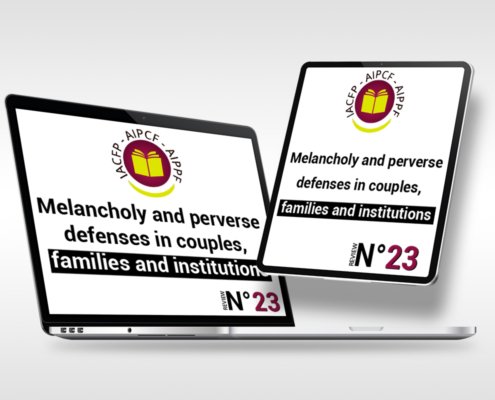REVIEW N° 23 | YEAR 2020 / 2
Introduction to the issue
“Melancholy and perverse defenses in couples, families and institutions”
Christophe Bittolo[1], Rosa Jaitin[2]
Melancholy, whether overt or covert, takes a wide variety of forms in its clinical presentation. Usually, it follows an experience of loss which sometimes has catastrophic features that could not be transformed through the work of mourning and which prompts remembering, repetition or structure in the organisation of the psyche. The distinction between an exploration of loss in mourning and the pathological deviations of melancholy were highlighted by Freud as early as 1917.
In the clinical setting for groups, couples, and families, these deviations are commonly manifested by the establishment of perverse defences of a sexual and/or narcissistic nature and on several levels. Such defences aim to deny “identity distress”, to protect oneself from disorganisation both intrapsychically and intersubjectively by making it a burden for one or more others. In doing so, these defences, in turn, generate an intra- and interpsychic suffering variously expressed as: excitement, acting out, somatisation, confusion, holding on, denial… This evolving collection testifies to the dismantling of an ideal super-ego that is conducive to the growth of the subject and the group, in favour of tyrannical, extremist, or destructive forms that refute the value of law, of rule, and of thought.
Such deleterious processes, in the very contexts where they are clinically recognised, are particularly difficult to identify and change, especially as they often take place within institutional, social, and meta-settings that are themselves suffering in similar ways.
How can couple and family therapies, work in groups, or in institutions contribute to change in these complex and reputedly difficult configurations of therapeutic activity? It is to these questions that the first European Francophone Day of the AIPCF, held in Paris in October 2019, attempted to find answers. This issue of the journal summarises its contributions and seeks to shed light on these problematic matters. The presentations and debates were based on a clinical discussion that was sufficiently long to encourage the exchange of ideas. Several points emerge.
The importance of the development of a negative countertransference, communicated in the therapeutic or institutional setting, constitutes a privileged medium of access to the suffering in question. This elaboration, which is synonymous with defences against powerful countertransferential actions of the clinician and a denial of the thought processes that support psychic growth, can also be found in family clinics (Sanahuja), in couple therapy (Robert, Joubert), as well as in complex institutional configurations (Carel).
It presupposes the construction and approach of a “neo-container”, synonymous with “neo-transference” according to Pierre Benghozi, as a group transferencecountertransference co-construction associated with the therapeutic plan for which it provides the framework.
The loss, which could have followed the path of mourning, instead mobilises catastrophic or haemorrhagic anguish on such a scale that a potentially perverse reorganisation is necessary to preserve the narcissistic economy of the link or the group.
The authors take up here the singularity of melancholic loss, as Freud was able to highlight it, in underlining the narcissistic investment in the object. Narcissism links in varying degrees, and in ways that psychotherapy explores or perceives when these links are in crisis. All couples and groups are in fact affected by a narcissistic regimen that ensures a shared defensive protection: the notion of a de-negative pact (Kaës) reflects this. Philippe Robert emphasises the economic dimension of the narcissistic pact in couple relationships. A vital struggle for “inseparability” can thus go so far as to make the other into a tool, an object in the concrete sense, or to nourish those bonds of power whose incestuous extent (in Racamier’s terms) is to be distinguished from incest proper.
Narcissism then appears to be a key concept for understanding the defensive modalities at play in these configurations. A guiding thread to explore this labyrinth of the “inextricable” of certain institutional situations undergoing great suffering (Carel), it places the ideal of the self and narcissistic omnipotence at the heart of homeostatic priorities and the economy of family or institutional groups.
It is indeed to the unconscious shame of inheritance (Benghozi) or the narcissistic haemorrhage of loss that the organisation of narcissistic perversion responds in certain situations. It is a multi-dimensional defence: relating to the subject, family, group, or institution, in which the subjects who participate sometimes, in spite of themselves, suffer confusion, depression, disqualification.
The interlocking of “perverse defences” according to Racamier’s formulation can thus be seen as a “strategy to deceive the void”? (Benghozi). Double bind, narcissistic perversion, incest then constitute a defensive trilogy for which André Carel proposes an epigenesis, in the course of the development of the subject, the family and the institution.
This narcissistic perversion has the founding vocation of trying to ensure the narcissistic safeguard of the subject in distress, which must be converted into triumph, and at the expense of one or more other subjects maintained under the paradoxical cloak of the narcissistic object.
These proposals are supported by rich and detailed clinical material, which is echoed by the role-playing technique with an audience that Rosa Jaitin describes for us.
Another contribution completes this dossier, the richness of which should inspire other developments. His theme is quite close to our own concerns the markers of perverse sexuality as a retreat from a psychotic crisis, a point of fixation that has become an instrument of one’s own pleasure.
We hope you enjoy reading this issue and remain open to receiving your comments.
[1] Psychologist, Psychoanalyst, Group and Institutional Analyst (Versailles). Senior Lecturer, Laboratory of Clinical Psychology, Psychopathology, Psychoanalysis, University of Paris. christophebittolo@me.com
[2] Doctor in Clinical Psychology and Psychopatology, Group, Couple and Family Psychoanalyst. Professor Emerita of the University of Buenos Aires associated with the University of Paris, President of the International Psychoanalytic Association of Couple and Family.
jaitin@icloud.com

